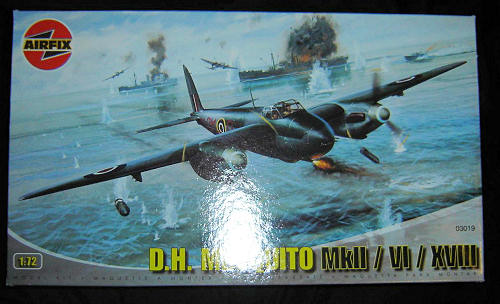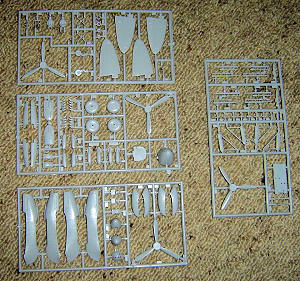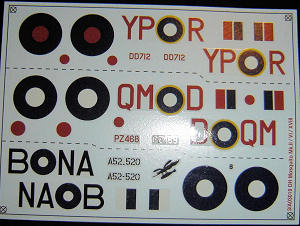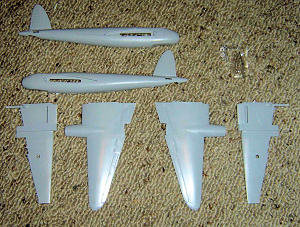Airfix 1/72 Mosquito Mk. II/VI/XVIII
|
KIT: |
Airfix 1/72 Mosquito Mk. II/VI/XVIII |
|
KIT #: |
03019 |
|
PRICE: |
NZ $17.00 |
|
DECALS: |
Three options |
|
REVIEWER: |
Zac Yates |
|
NOTES: |
|

Ok, as there are several very fine Modeling Madness
reviews/previews of the various Mossie kits currently (and previously)
available, for a full, detailed and accurate history I suggest you take a look
there. Alternatively, the terrific website
www.mossie.org
is a great one-stop-shop for all your DH.98 info needs! I could rant and rave
and go on in a massive essay – with footnotes – about the history of this most
elegant of wooden warplanes, but I won’t.
Airfix,
in the meantime, says: “Probably no other aircraft during the Second World War
captured the public’s imagination more than the de Havilland Mosquito. Its
daring low-level raids against selected targets in enemy occupied Europe and the
success it attained in the night-fighter and anti-shipping roles all added up to
one of the most outstanding aircraft of the period.
The
prototype two-seat Mosquito first flew in 1940 to an Air Ministry specification
B.1/40, for an unarmed high-speed bomber-recce aircraft. Further development
produced a night fighter version, the NF.11, of which 466 were built, service
entry with RAF Fighter Command coming in January 1942, the type equipped
initially with A.I. Mk.IV radar.
“Following
the success of the Mk.II on intruder operations, came the Mk.VI fighter bomber,
the most widely used of all Mosquito fighters (2,500 built). In addition to the
four 20 mm cannon and four .303 machine guns in the nose, internal and external
bombs could be carried as well as eight wing-mounted rockets. From the beginning
of 1944, this version operated with Coastal Command with considerable success
against convoys and coastal shipping and with the addition of a 57 mm Molins
gun, the designation change to
Mk.XVIII (27 built).
“Prior
to D-Day, Mosquitos undertook many precision low-level attacks on the Continent
including one on the jail at
Amiens
and another on the Gestapo Headquarters in
Copenhagen.
In the Far East Mk.VIs operated against the Japanese from the beginning of
1944.”
 Well, where
to start? In your top-opening cardboard box you get an instruction booklet of
two A3 folded in half, with six steps including pa
Well, where
to start? In your top-opening cardboard box you get an instruction booklet of
two A3 folded in half, with six steps including pa int/decaling.
The decal sheet itself is rather glossy, but the colours look to be about right
– my copy had small dents, almost like pinpricks, on several areas of decal.
Nothing likely to affect it, but that’s ok as I was planning on raiding my
spares box anyway. The kit options are: a NF.II of 23 Sqn RAF (DD712/YP-R), an
FB.VI of 1 Sqn RAAF (A52-520/NA-B) and a Mk.XVIII of the curiously-numbered
248/254 Sqn RAF (PZ468/QM-D). What I find interesting – and commendable in some
ways – is that Airfix included markings for an FB.VI NOT of the RAF, principal
user of the type. I’m not complaining as I’ve seen precious few “mainstream”
kits issues with RAAF decals, but it is interesting considering the usage of
this most numerous subtype by English units.
int/decaling.
The decal sheet itself is rather glossy, but the colours look to be about right
– my copy had small dents, almost like pinpricks, on several areas of decal.
Nothing likely to affect it, but that’s ok as I was planning on raiding my
spares box anyway. The kit options are: a NF.II of 23 Sqn RAF (DD712/YP-R), an
FB.VI of 1 Sqn RAAF (A52-520/NA-B) and a Mk.XVIII of the curiously-numbered
248/254 Sqn RAF (PZ468/QM-D). What I find interesting – and commendable in some
ways – is that Airfix included markings for an FB.VI NOT of the RAF, principal
user of the type. I’m not complaining as I’ve seen precious few “mainstream”
kits issues with RAAF decals, but it is interesting considering the usage of
this most numerous subtype by English units.

The
kit itself is what we have come to expect from Airfix over the years. Four
sprues of grey and one of clear (crystal at that, although very thick and
probably best replaced by a vacform example), with the fuselage halves and wing
uppers and unders loose, all in a sealed bag (except for the clear sprue, left
floating around to its own devices). Considering the markings and variant
options you get a good amount of “kit” in your kit – shrouded or unshrouded
exhausts, drop tanks, underwing bombs and rockets, the XVIII-exclusive Molins
cannon installation (these were nicknamed “Tsetse” by their crews) and a
standard four-gun-four-cannon nose, AI antenna, and the obligatory pilots. I
think most builders who visit this site will possibly leave them on the sprue!
The
plastic is, again, standard Airfix, nicely formed with a bit of flash (mostly
around gunports) and fairly thick. This may pose a problem to those of us – like
me – planning to have the bombbay doors open, or the crew entry hatch (not sure
how I’ll manage that), or who want to modify the kit into a bomber variant. Not
impossible, but skills would be necessary. The panel line detail is raised, so
those so inclined will likely delete and rescribe. There is also pronounced
rivet detail around the radiators and on the nacelles, which is a touch
overscale compared to photos of preserved examples.
The
cockpit is what really lets this lady down. There’s a floor, the aforementioned
crew (one of whom, presumably the nav, is legless!), a very simple instrument
panel, two identical bucket seats and a Black BoxTM. I don’t want to bore you
with the pedantics of how inaccurate this is – I tend to get raging headaches
when I do – so I’ll just say it’s just as well the canopy is so thick. I was
considering for a while investing in an aftermarket set to make this look a bit
more pretty but eventually changed my mind (see below). However, if you are
determined to make this lady look her best, do yourself a favour and source a
new, thinner canopy first.
As far as I’m
aware, in 1:72 for your Mossie pleasure you have this, the Hasegawa range (about
which I’ve read and seen little) and the Tamiya wonderkit. Some of you are
likely thinking, “why go for the decades-old Airfix offering when there’s the
Tamiya gem?”. And fair enough, too. Dry-fitting this bird and looking at the
work to get alignment and panel lines right, as well as the barren cockpit, had
me thinking the same. I’ll put it simply: for the price of the Tamiya Mossie in
this scale, I could buy TWO of this kit. And for a 20 year-old supermarket
employee, that’s a big difference. Besides, I’m planning to make this my final
1:72 kit before converting fully to
1:48…THEN
I’ll invest in a Tamiya kit! And she will be a thing of beauty! Watch this
space.
Long
story short – if you, or your kid (or grandkid!) want a Mosquito and you want it
NOW, grab this. A weekend wonder of the Wooden Wonder.
Review
kit courtesy of my MasterCard.
If you would like your product reviewed fairly and quickly, please
contact
me or see other details in the
Note to
Contributors.
Back to the Main Page
Back to the Previews Index Page


 Well, where
to start? In your top-opening cardboard box you get an instruction booklet of
two A3 folded in half, with six steps including pa
Well, where
to start? In your top-opening cardboard box you get an instruction booklet of
two A3 folded in half, with six steps including pa int/decaling.
The decal sheet itself is rather glossy, but the colours look to be about right
– my copy had small dents, almost like pinpricks, on several areas of decal.
Nothing likely to affect it, but that’s ok as I was planning on raiding my
spares box anyway. The kit options are: a NF.II of 23 Sqn RAF (DD712/YP-R), an
FB.VI of 1 Sqn RAAF (A52-520/NA-B) and a Mk.XVIII of the curiously-numbered
248/254 Sqn RAF (PZ468/QM-D). What I find interesting – and commendable in some
ways – is that Airfix included markings for an FB.VI NOT of the RAF, principal
user of the type. I’m not complaining as I’ve seen precious few “mainstream”
kits issues with RAAF decals, but it is interesting considering the usage of
this most numerous subtype by English units.
int/decaling.
The decal sheet itself is rather glossy, but the colours look to be about right
– my copy had small dents, almost like pinpricks, on several areas of decal.
Nothing likely to affect it, but that’s ok as I was planning on raiding my
spares box anyway. The kit options are: a NF.II of 23 Sqn RAF (DD712/YP-R), an
FB.VI of 1 Sqn RAAF (A52-520/NA-B) and a Mk.XVIII of the curiously-numbered
248/254 Sqn RAF (PZ468/QM-D). What I find interesting – and commendable in some
ways – is that Airfix included markings for an FB.VI NOT of the RAF, principal
user of the type. I’m not complaining as I’ve seen precious few “mainstream”
kits issues with RAAF decals, but it is interesting considering the usage of
this most numerous subtype by English units.